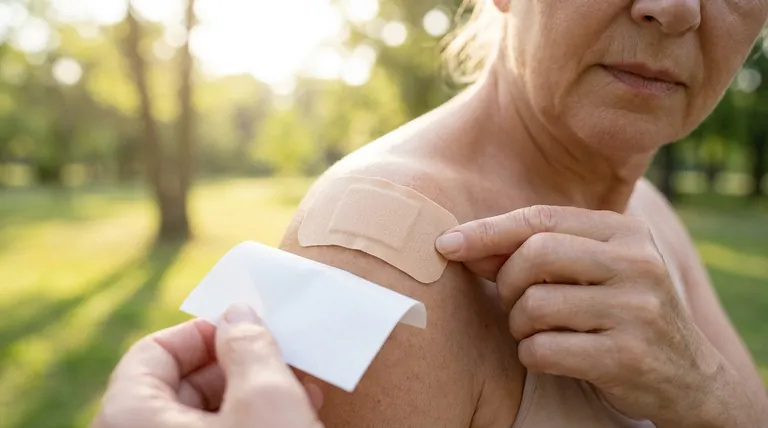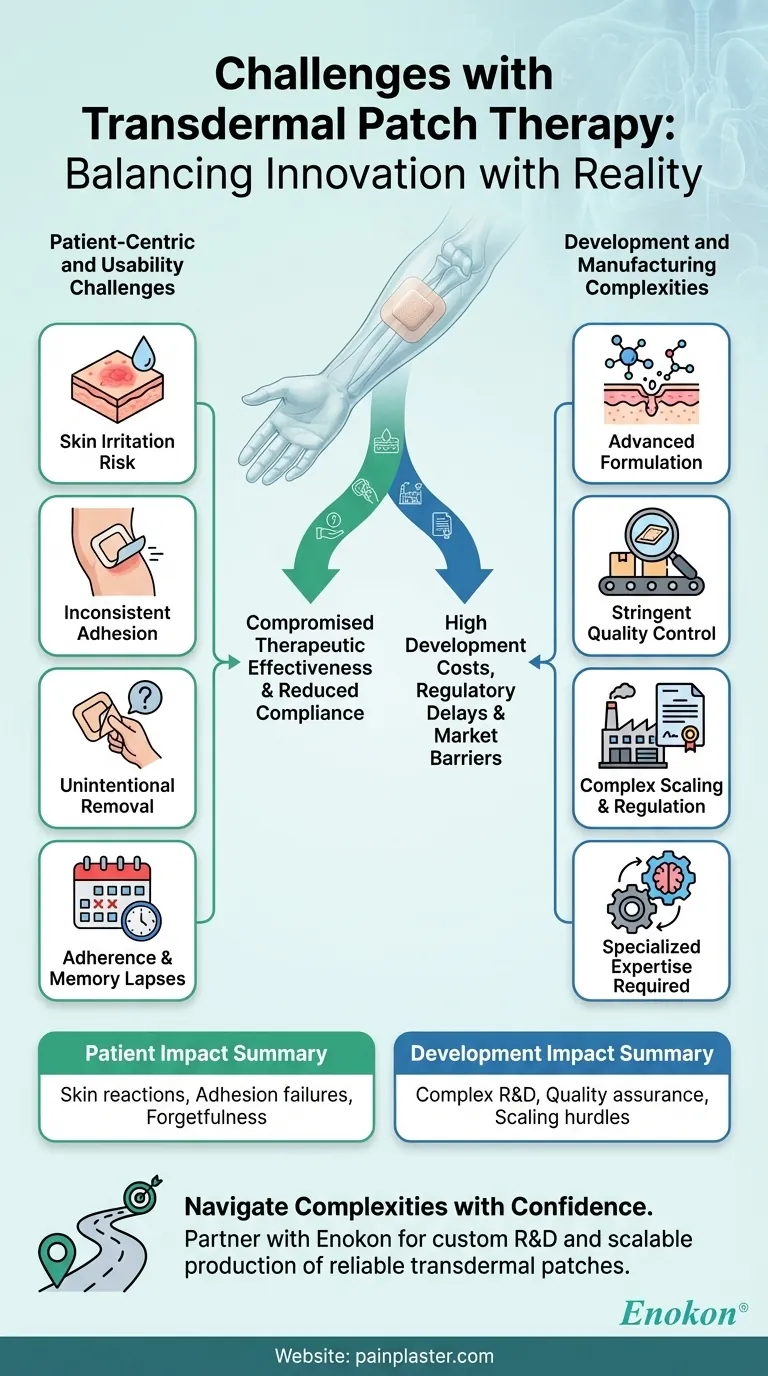While offering a unique method of drug delivery, transdermal patch therapy presents distinct challenges that span from patient adherence to complex manufacturing. The primary hurdles include the risk of skin irritation, inconsistent adhesion, potential for patient interference, and the significant technical expertise needed for successful formulation and commercial production.
The challenges of transdermal patches are twofold: patient-centric issues like skin compatibility and adherence can compromise therapeutic effectiveness, while complex development and manufacturing hurdles create significant barriers to bringing a product to market.

Patient-Centric and Usability Challenges
The most immediate challenges are those faced by the end-user. The success of the therapy depends entirely on the patient's ability to use the patch correctly and consistently, but several factors can interfere.
The Risk of Skin Irritation
The adhesive and the active drug itself can cause local skin reactions, such as redness, itching, or irritation. This can lead to discomfort and may cause the patient to discontinue therapy.
Ensuring Consistent Adhesion
A patch must remain securely attached to the skin to deliver its medication correctly. Factors like sweat, body movement, and individual skin type can compromise adhesion, potentially leading to a partial or complete loss of dose.
Unintentional Removal or Interference
Patients, particularly those with cognitive impairments or pediatric patients, may forget they are wearing a patch and remove it accidentally. This immediately stops the therapeutic effect and creates a safety risk if the patch is mishandled.
Overcoming Unfamiliarity and Memory Lapses
Unlike a daily oral medication, a patch may only need to be changed every few days or once a week. This less frequent schedule can be harder to remember, breaking the routine that helps ensure adherence with other forms of medicine.
Development and Manufacturing Complexities
Beyond the patient experience, creating a viable transdermal patch is a significant technical undertaking that requires specialized expertise and resources.
Advanced Formulation and Chemistry
Developing a formulation that allows a drug molecule to effectively penetrate the skin's protective outer layer is a major scientific hurdle. This requires deep expertise in chemistry and material science.
Stringent Manufacturing and Quality Control
Ensuring that every patch is manufactured with a consistent dose, proper adhesion, and stable shelf-life involves complex Chemistry, Manufacturing, and Controls (CMC). This process is highly regulated and difficult to scale.
The Need for a Specialized Partner
Successfully navigating formulation, analytical testing, regulatory compliance, and commercial-scale manufacturing is rare for a single organization. A reliable partner with a proven track record is often essential for moving from a feasibility study to market production.
Understanding the Trade-offs
Choosing a transdermal delivery system requires a clear-eyed assessment of its inherent benefits versus its challenges. These trade-offs exist on both the patient and development levels.
Benefit vs. Burden for the Patient
The primary benefit for the patient is avoiding daily pills and maintaining a steady level of medication. However, this is weighed against the potential burden of skin irritation, adhesion failures, and the need to remember a non-daily schedule.
Cost vs. Efficacy for the Developer
The development pathway for a transdermal patch is often more complex and costly than for an oral solid dose. This higher upfront investment must be justified by a clear clinical advantage, such as improved patient compliance or a better therapeutic outcome.
Making an Informed Decision for Your Goal
To determine if a transdermal patch is the right approach, you must align your primary objective with the therapy's known strengths and weaknesses.
- If your primary focus is patient compliance in a forgetful population: You must implement robust patient education and reminder systems to mitigate the risk of users forgetting to change the patch on schedule.
- If your primary focus is developing a new therapeutic product: Engage with a specialized manufacturing partner early to ensure the formulation is scalable and meets all regulatory and quality assurance requirements from day one.
- If your primary focus is treating patients with sensitive skin: Prioritize material science by selecting adhesives and backing materials with a proven history of low irritation to minimize the risk of adverse skin reactions.
By proactively addressing these patient and production challenges, you can successfully leverage the unique advantages of transdermal drug delivery.
Summary Table:
| Challenge Category | Key Hurdles | Potential Impact |
|---|---|---|
| Patient & Usability | Skin irritation, inconsistent adhesion, unintentional removal | Compromised therapy, reduced patient compliance |
| Development & Manufacturing | Complex formulation, stringent quality control, scaling production | High development costs, regulatory delays, market entry barriers |
Navigate the complexities of transdermal patch development with confidence. Partner with Enokon, a bulk manufacturer of reliable transdermal patches and pain plasters. Our technical expertise in custom R&D and scalable production helps healthcare and pharma distributors and brands overcome formulation hurdles, ensure stringent quality control, and bring effective products to market efficiently.
Contact our experts today to discuss your specific project needs and benefit from our proven track record.
Visual Guide

Related Products
- Far Infrared Heat Pain Relief Patches Transdermal Patches
- Herbal Eye Protection Patch Eye Patch
- Heating Pain Relief Patches for Menstrual Cramps
- Menthol Gel Pain Relief Patch
- Icy Hot Menthol Medicine Pain Relief Patch
People Also Ask
- How quickly does the Deep Heat Pain Relief Back Patch activate and how long does it provide warmth? Get 16-Hour Relief
- How do Deep Heat Pain Relief Patches provide pain relief? Discover the Drug-Free Mechanism
- What are the key features of the Deep Heat Pain Relief Back Patch? Get Up to 16 Hours of Drug-Free Relief
- What did the UK Million Women Study find regarding transdermal versus oral hormone therapy? A Safer Choice for Gallbladder Health
- Can heat patches be used for fresh injuries? Avoid This Common Mistake for Faster Recovery













